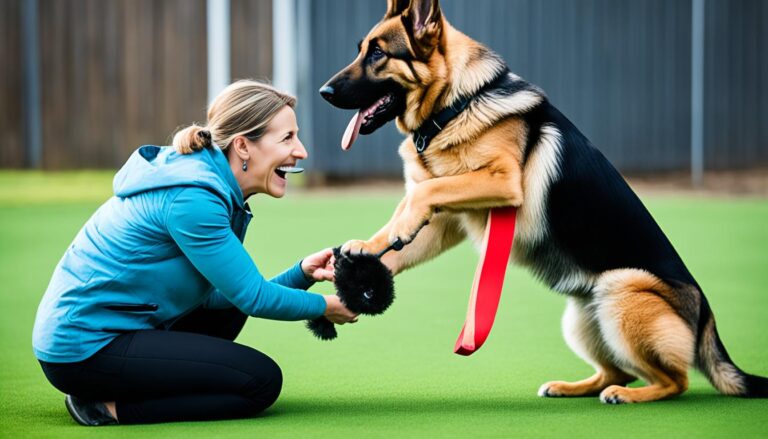Quiet Puppy Adoption: Shelters & Rescues Guide
When it comes to adopting a quiet puppy, finding the right shelter or rescue is key. The process of adopting a shelter dog can seem overwhelming, given the uncertainties surrounding their true personalities. However, with the right knowledge and guidance, you can find the perfect companion that matches your lifestyle and preferences.
At [Brand Name], we understand the importance of adopting a quiet puppy and the impact it can have on both your life and theirs. We have compiled this comprehensive guide to help you navigate the process with confidence and ensure a successful adoption experience.
Key Takeaways:
- Choosing the right shelter or rescue is crucial for finding a quiet puppy.
- Understanding dog body language is essential when searching for a calm companion.
- Patiently bond with your new puppy, following the 3/3/3 rule for optimal results.
- Establishing boundaries and consistent training is necessary during the settling-in period.
- A successful adoption involves creating a comfortable and nurturing environment for your new puppy to thrive.
How to Choose the Right Shelter Dog
When searching for a quiet puppy in a shelter, it’s essential to have a strategy. Start by knowing what you want in a dog, such as energy level and sociability, rather than focusing on specific breeds.
Understanding dog body language is also crucial. It can help you differentiate between a dog who is genuinely calm and one who has shut down due to stress. Look for signs of relaxation, such as a loose body and wagging tail, as well as signs of anxiety or fear, such as trembling or lowered body posture.
Don’t be afraid to spend quality time with the dog you are considering adopting. Take them for a walk, play with them, and interact in a quiet environment to see how they respond. This can give you insight into their temperament and behavior.
Choosing a shelter that provides individual attention to their dogs and has knowledgeable staff can greatly increase your chances of finding the right match. These shelters prioritize the well-being and behavioral assessment of each dog, ensuring that they are ready for adoption and that their true personality shines through.
Remember, a dog’s behavior in the shelter may not necessarily reflect their behavior in a home environment. Some dogs may be stressed or anxious in a shelter setting but thrive in a calm, loving home. Be patient and give the dog a chance to show their true colors.
As you explore different shelters and interact with dogs, keep in mind that the goal is to find a quiet and compatible companion. Look for a dog whose energy level matches your lifestyle and who has the temperament you desire.
Quiet Puppy Adoption Tips:
- Focus on a dog’s behavior and energy level rather than specific breeds.
- Observe the dog’s body language to differentiate between calm and stressed behaviors.
- Spend quality time with the dog in a quiet environment to assess their temperament.
- Choose a shelter that prioritizes individual attention and behavioral assessments.
- Be patient and give the dog time to adjust to their new home.

By following these tips and guidelines, you can increase your chances of finding a quiet puppy that is a perfect fit for your lifestyle. The next section will guide you through the settling-in period and bonding process with your newly adopted dog.
The 3/3/3 Rule: What to Expect in the First Three Days, Three Weeks, and Three Months
When you bring a new dog into your home, it’s essential to understand the settling-in period and the process of bonding. The first three days are crucial as they set the foundation for a smooth transition. During this time, your new dog may feel overwhelmed and unsure, adjusting to their new environment and routine. It’s important to give them time and space to adapt without rushing the bonding process.
Over the next three weeks, your dog will start to settle in and show their true personality. This is a critical period for establishing boundaries, training, and building a strong bond. Each day, you will witness your dog gaining confidence and becoming more comfortable in their new home. Consistency, patience, and positive reinforcement are key during this phase.
By the end of the first three months, your dog should be fully settled and comfortable in their new home. A strong bond should have been formed between you and your furry companion. During this period, you will have had the opportunity to understand their needs, preferences, and quirks. Together, you’ll have gone through several milestones, creating a deep and lasting connection.
“The first three days, weeks, and months are critical for establishing trust, routine, and a solid bond. Patience and understanding are the key ingredients to a successful transition.”
Benefits of the 3/3/3 Rule
The 3/3/3 Rule provides a structured approach to welcoming a new dog into your home. It allows both you and your dog to gradually adapt, ensuring a smoother settling-in period and a stronger bond in the long run. By giving your dog time and space to acclimate to their new surroundings, you’re creating a nurturing environment for growth and development.
Here’s a table summarizing the key aspects of the 3/3/3 Rule:
| Timeframe | Focus |
|---|---|
| First three days | Allowing time to adjust and avoiding rushing the bonding process |
| Next three weeks | Establishing boundaries, training, and building a strong bond |
| First three months | Full settling, comfort, and a deep bond between dog and owner |
Conclusion
Adopting a quiet puppy from a shelter or rescue can be a rewarding experience. By following the guidelines and tips mentioned in this guide, prospective owners can navigate the adoption process with success. It’s important to take the time to choose the right dog, understand dog behavior, and provide a comfortable and consistent environment for the new dog to thrive.
When adopting a shelter dog, remember that creating a bond with a new dog takes patience, care, and consistency. Dogs may need time to adjust to their new surroundings and may exhibit different behaviors during the settling-in period. By being understanding and providing a supportive environment, owners can help their adopted dog feel safe and secure. Building a bond based on trust and love is essential in developing a successful relationship.
Successful dog adoption requires effort and dedication. It’s crucial to give the new dog time to adjust and adapt to their new home. By providing proper training, socialization, and regular exercise, owners can help their adopted dog become a well-rounded and happy member of the family. Remember, adoption is a commitment, and the love and companionship that you receive from your adopted pup will make it all worthwhile.
FAQ
How can I find a quiet puppy in a shelter or rescue?
When searching for a quiet puppy, it’s important to have a strategy. Focus on the dog’s energy level and sociability, rather than specific breeds. Understanding dog body language can also help differentiate between a naturally calm dog and one who is stressed. Choose a reputable shelter or rescue that provides individual attention to their dogs and has knowledgeable staff.
What should I expect during the first few days after adopting a quiet puppy?
The first few days are a time of adjustment for both you and your new dog. It’s important to give them time to acclimate to their new surroundings and not rush the bonding process. Be patient and allow the dog to set the pace for building trust and comfort.
What is the 3/3/3 rule when adopting a dog?
The 3/3/3 rule refers to the general timeline for a dog’s adjustment after adoption. In the first three days, the dog may still feel overwhelmed and unsure. Over the next three weeks, they will begin to settle in and show their true personality. By the end of the first three months, the dog should be comfortable in their new home, and a strong bond should have formed with their owner.
How can I create a strong bond with my adopted quiet puppy?
To create a strong bond with your new puppy, provide them with a comfortable and consistent environment. Establish boundaries and a routine from the start, and be consistent with training. Show them love, patience, and positive reinforcement. Spend quality time together, engaging in activities that build trust and strengthen the bond between you and your dog.







